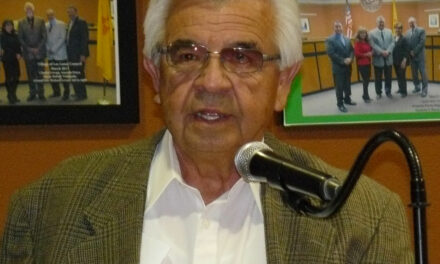One concern of some citizens who’ve spoken out against the Peoples Energy Resources proposed power plant, to be built south of Rio Communities, is that there might be a large earthquake along the Rio Grande Rift that could cause an explosion.
However, earthquake experts in New Mexico say there is a very small chance of that happening in the lifetime of those alive today.
“There are major faults located all along the Rio Grande Valley, including some in the vicinity of the proposed power plant. However, the time interval between large earthquakes on these faults averages many tens of thousands of years. Therefore, the probability that such events will occur during the lifetime of a power plant is extremely low,” said Dr. Allan R. Sanford, professor emeritus of geophysics at New Mexico Tech in Socorro.
“The inflation of a mid-crustal magma body beneath the Socorro area is responsible for an unusual clustering of activity, with a northern border lying a short distance south of the proposed power plant site,” he said.
“However, there is only a 10 percent probability in 50 years that this activity will produce ground motions that could cause significant damage to weakly built or designed structures, for example, unreinforced masonry structures or adobe. Properly designed and built modern power plants should sustain little or no damage from expected ground motions produced by moderate earthquakes generated by inflation of the Socorro magma body.”
Sanford has been studying earthquakes in New Mexico since 1959. He has researched historical journals and records to determine the earthquake activity of the past.
There have been no earthquakes larger than magnitude 6 in New Mexico in 150 years. During that time, there have been 36 earthquakes between 4 and 5.8 in magnitude.
The impact of such tremors in this region would be:
- Magnitude 4, knocking of books off a bookshelf.
- Magnitude 5, cracking of windows.
- Magnitude 6, significant damage to primitive structures such as those made with adobe and unreinforced masonry.
The largest magnitude earthquakes to occur in New Mexico in the past 150 years were approximately 5.8, which occurred in the Socorro area twice in 1906, on July 16 and Nov. 15.
“In most areas, you have to have a magnitude of 6.5 and above for widespread structural damage to occur,” said Dr. Richard Aster, professor of geophysics at New Mexico Tech. “Precarious rock formations in New Mexico and the region which have caprocks balanced on wind- and water-eroded pedestals suggest that this area has not had an earthquake of this magnitude in many hundreds or thousands of years.”
The records show there were earthquakes in the Belen area in 1893 and 1935, with an estimated magnitude of 5.2 and 4.5, respectively.
Most of the earthquakes occurring in New Mexico are of a magnitude of less than 3. Between 1963 and 1995, there were 1,777 in this category. Of those, 30 percent, or 536, were in the Socorro area.
Comparing the earthquake activity in California to New Mexico, Sanford said that, in the last 150 years, the west coast has had about 150 earthquakes with a magnitude of six or greater, while New Mexico has had none.
“We’re not in the same league as California,” he said. “The earthquakes in our area are caused by different activity.”
Most of California’s earthquakes are directly due to the movement of the Pacific Plate relative to the North American Plate, according to Aster.
“During the past about 30 million years, there has been a much slower stretching of the North American Plate around the Colorado Plateau, including the Rio Grande Rift, that runs the length of our state” Aster said. “The Rio Grande Rift is presently spreading at a rate of 0.1 millimeters (0.04 inches) a year or less, which is about the thickness of a thick piece of paper.”
The earthquake activity in the Socorro area is not caused by the rift movement, but rather because of the unusual phenomena of an inflating magma pool located 11 miles below the earth’s surface in the area.
In New Mexico, earthquakes do not follow the state’s fault lines like most earthquakes in California, according to the mapping of the recorded earthquakes. Instead, they occur in the form of localized swarms.
The majority of these swarms in New Mexico occur in the Socorro area. This is because of the 50-by-30-mile magma body extending from a few miles north of Bernardo south to San Antonio.
Sanford discovered the magma body as he reviewed the seismic recordings from the earthquakes in the area.
The scientist and his colleagues mapped the boundaries of the pool by studying the way earthquake waves bounced off of it.
Using New Mexico Tech’s network of seismographs to track the waves, they concluded the magma pool is a rough, thin oval a few hundred feet thick in most places.
Normally, an earthquake has two distinct energy arrivals, but recordings of New Mexico tremors showed additional signals reflected off the magma body.
Magma is weaker than solid rock and so reflects the waves like a mirror reflecting light. If there is no magma present, the waves travel deeper into the earth without reflecting.
While the magma shows no signs of bursting through the surface in a volcanic eruption anytime soon, the magma body is expanding and pushing up the earth’s surface at a rate of about 2 millimeters (about one-tenth of an inch) a year. This movement causes the earth’s upper crust to crack, similar to the way paint on a balloon cracks as the balloon is inflated, causing small but noticeable earthquakes in the area.
Sanford believes the magma pool is “a few tens of thousands of years old” — young in geological terms on a planet more than 4 billion years old.
The magma apparently came up from the earth’s mantle through a conduit or set of conduits and then spread out sideways when it hit the crust’s lighter upper rocks, the scientist said.
“The Socorro magma body could freeze up and change from molten to rock,” Aster said. “Or it might follow a fault line to the surface, like the 6,000-year-old lava flow by Carrizozo. Or even conceivably someday be released in a violent volcano such as the one which blew the top off of the Jemez Mountains over a million years ago, but none of these will likely happen within the lifetimes of the people alive today,”
In a recent seismic mapping of the region from Utah to Texas on a diagonal line across New Mexico by Aster and other researchers, a forked structure of hot rock beginning hundreds of miles under the earth was imaged with the west fork pointing toward Jemez and the east fork pointing toward Carrizozo. However, the relatively tiny Socorro magma pool, which is located between the two forks, was not apparent at this grand scale.
Sanford and Aster said another reason earthquake magnitudes are less than those in California is because of the thickness of the earth’s brittle crust in New Mexico.
The crust is about 20 miles thick under the Rio Grande rift, which is relatively thin.
“In this area, the brittle portion is only about one to five miles deep, which is another reason why our earthquakes are not as severe. The deeper the brittle crust, the greater the potential magnitude of the earthquake.”
















